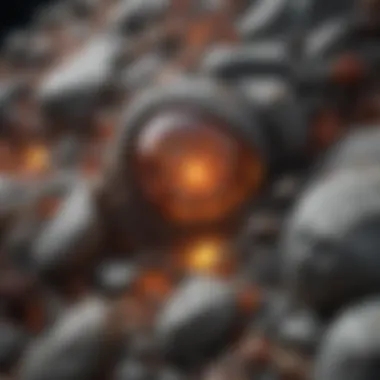Unraveling the Enigmatic Composition of Granite: A Geological Insight


Rock and Fossil Identification
Granite, a fascinating igneous rock known for its durability and intricate composition, poses a unique challenge in rock and fossil identification. Understanding the types of rocks and fossils embedded within granite formations is essential for enthusiasts looking to delve deeper into the world of geology. When identifying granite rocks, one should look for distinct characteristics such as grain size, mineral composition, and color variations. Specialized tools like magnifying glasses, rock hammers, and geological maps can aid in the accurate identification of minerals within granite.
Collecting Tips and Techniques
For rock and fossil collectors seeking to expand their collection to include granite specimens, mastering best practices is crucial. Locating prime collecting sites rich in granite deposits requires thorough research and geological knowledge. Once a suitable site is found, it is essential to employ safe extraction techniques to preserve the integrity of the granite samples. Techniques like chiseling, hammering, and using protective gear ensure the successful extraction of granite specimens without damaging their natural form.
Preservation and Display
Preserving granite specimens is crucial to maintaining their quality and appearance over time. Various techniques, such as sealing with mineral oil or using epoxy resin, can enhance the durability and sheen of granite surfaces. Proper storage methods, including storing in cool, dry environments away from sunlight, prevent discoloration or erosion of the rock. Creative display ideas, such as mounting granite slabs on wooden stands or incorporating them into decorative rock gardens, offer unique ways to showcase these geological marvels.
Geological Insights
Delving deeper into the geological insights of granite composition unveils a wealth of knowledge about Earth's history and natural processes. Understanding the geological formations that give rise to granite rocks sheds light on the intricate processes of magma crystallization and mineral deposition. Granite holds historical significance in architecture, art, and scientific research, making notable discoveries in the field invaluable for expanding our understanding of geology's complexities.
Introduction to Granite
In the realm of geology, an Introduction to Granite is a crucial starting point for understanding the complexities of this igneous rock. Granite, with its illustrious history and abundant presence in the Earth's crust, holds a special place in the world of rocks and minerals. By delving into the composition of granite, we uncover a treasure trove of knowledge that reveals its significance in various applications. The core elements, benefits, and considerations of Introduction to Granite pave the way for a more profound exploration of this enduring geological marvel.
Defining Granite
When it comes to defining granite, we must acknowledge its intricate nature. Granite is a coarse-grained igneous rock comprising predominantly quartz, feldspar, and mica, among other minerals. Its formation through the slow cooling of magma deep within the Earth's crust results in its unique composition and striking appearance. Understanding the distinct characteristics that define granite sets the stage for recognizing its importance and widespread use in diverse industries.
Significance of Granite


The significance of granite transcends its physical attributes. This rock has stood the test of time, adorning ancient architectural wonders and modern constructions alike. Its durability, beauty, and distinct grain patterns make it a sought-after material for various applications. Moreover, granite holds geological significance, offering a window into the Earth's past through its formation process and mineral composition. Exploring the significance of granite unveils a deeper connection to our planet's history and the enduring allure of this mesmerizing rock.
Mineral Composition of Granite
The Mineral Composition of Granite is a pivotal aspect of this article, as it provides the fundamental building blocks that define this remarkable igneous rock. Understanding the specific elements that make up granite is crucial to comprehending its formation, properties, and uses. By delving deep into the mineral composition, we can unravel the mysteries behind the allure and durability of granite. This section will explore the significance of the Mineral Composition of Granite in unlocking the secrets of this ancient rock formation.
Quartz
Quartz is a key mineral in granite composition, known for its crystalline structure and durability. Comprising a significant portion of granite, quartz enriches the rock with its hardness and resistance to weathering. As one of the primary components, quartz contributes to the intricate texture and color variations observed in different types of granite. Understanding the role of quartz in granite composition is essential for appreciating the strength and beauty that this mineral imparts to the rock.
Feldspar
Feldspar, another essential mineral in granite, plays a crucial role in defining the overall composition and appearance of the rock. With its distinct cleavage and color variations, feldspar adds both aesthetic appeal and structural integrity to granite. As one of the most abundant minerals in Earth's crust, feldspar's presence in granite contributes to its diverse range of colors and patterns. Exploring the characteristics and significance of feldspar in granite unveils a deeper understanding of this versatile and enduring rock.
Mica
Mica, a unique mineral found in granite, introduces a lustrous sheen and texture to the rock. Known for its flexibility and heat resistance, mica enhances the visual appeal and performance of granite in various applications. The presence of mica in granite not only adds a distinctive shimmer but also influences its durability and workability. By examining the role and properties of mica in granite composition, we can grasp the multidimensional nature of this captivating rock.
Other Minerals in Granite
Apart from quartz, feldspar, and mica, granite may contain a variety of other minerals that contribute to its overall composition and characteristics. These additional minerals, such as amphibole and biotite, add complexity and uniqueness to different types of granite formations. Exploring the diverse range of minerals found in granite expands our knowledge of the geologic processes and environments that have shaped this enduring rock. By uncovering the presence and significance of these other minerals in granite, we gain a more comprehensive perspective on the rich tapestry of elements that compose this natural masterpiece.
Formation Process of Granite
In the realm of granite composition, the Formation Process of Granite holds significant importance as it unravels the intricate journey of how this illustrious igneous rock comes into existence. Understanding this process is pivotal in comprehending the origins and unique characteristics of granite. The Formation Process elucidates how molten rock, known as magma, cools and solidifies beneath the Earth's surface over vast stretches of time, undergoing transformations that culminate in the creation of granite.


Diving deeper into the specifics of the Formation Process broadens our comprehension of the geological forces at play. Factors such as pressure, temperature, and the gradual cooling of magma contribute to the formation of distinct features within granite. This process results in the formation of crystals, giving granite its signature speckled appearance and remarkable durability. By shedding light on the Formation Process of Granite, this section serves as a foundation for unveiling the mysteries that lie within this captivating rock.
Intriguing Geological Formation
As we delve deeper into the intriguing Geological Formation of granite, we uncover the geological complexities that shape this remarkable rock. The formation of granite involves a series of intricate geological processes that span millions of years, forged deep within the Earth's crust. Through the amalgamation of various minerals and elements, granite forms through a slow and meticulous process of crystallization.
One of the most fascinating aspects of the Geological Formation of granite is how different environmental conditions influence its final composition. Factors such as the speed of cooling, the presence of other minerals, and the geological history of the region all play a crucial role in shaping the unique textures and patterns found in granite. This section delves into the captivating intricacies of how geological forces intertwine to give rise to the mesmerizing formations of granite, offering a glimpse into the Earth's ancient history.
Role of Magma in Granite Formation
An integral component of the granite formation process is the crucial Role of Magma. Magma, a molten mixture of minerals and rock fragments, plays a pivotal role in the creation of granite through a process known as magma crystallization. As magma slowly cools and solidifies underground, it undergoes a transformation, with minerals within the magma crystallizing and interlocking to form the distinct structure of granite.
Understanding the Role of Magma in granite formation provides insights into the conditions under which granite is created. The composition of magma, including the types of minerals present and their proportions, influences the final appearance and properties of the granite rock that emerges. By delving into the intricate dance between magma and geological forces, we unravel the secrets behind the formation of granite, showcasing the remarkable processes that shape the Earth's crust.
Geological Characteristics of Granite
Geological characteristics of granite play a pivotal role in understanding the intricate nature of this igneous rock. It is imperative to delve into the geological features of granite to grasp the essence of its formation and properties. By scrutinizing the texture and grain size, as well as the color variations in granite, we can unravel a plethora of insights that shed light on its geological significance.
Texture and Grain Size
The texture and grain size of granite are fundamental aspects that offer valuable clues about its formation process and durability. Granite is renowned for its coarse-grained texture, characterized by interlocking crystals that give it strength and resilience. The grain size varies depending on the cooling rate of magma, with slower cooling producing larger grains. Understanding the texture and grain size of granite is crucial for assessing its suitability for various applications, from construction to artistic endeavors.
Color Variations in Granite
Color variations in granite are a distinctive feature that showcases the diverse mineral composition and geological history of this rock. The colors in granite range from vibrant reds and pinks to soothing blues and greens, reflecting the presence of minerals such as quartz, feldspar, and mica. These color variations not only enhance the aesthetic appeal of granite but also provide valuable insights into its chemical composition and formation. Exploring the unique colors of granite unveils a spectrum of hues that capture the essence of its geological diversity.


Uses and Applications of Granite
Granite, with its remarkable durability and aesthetic appeal, finds a myriad of applications across various industries and settings. In this section, we will delve into the significance of the uses and applications of granite within the context of this article, focusing on its versatility and practical advantages. Granite has been a staple in construction for centuries, renowned for its strength and resistance to wear and tear. Its natural beauty and uniqueness make it a preferred choice in architectural design, adding a touch of sophistication to buildings and structures. Not only does granite elevate the visual appeal of spaces, but it also serves functional purposes due to its robust nature. In the realm of construction, granite countertops, tiles, and cladding are common applications that showcase the durability and elegance of this igneous rock. The longevity of granite makes it a sustainable option, reducing the need for frequent replacements and maintenance. Its ability to withstand extreme conditions and elements further enhances its desirability in construction projects.
Construction Industry
Within the construction industry, granite stands out as a premier building material that offers unparalleled strength and aesthetic value. Architects and builders appreciate granite for its resilience to environmental factors, making it an ideal choice for structures that require longevity and minimal upkeep. The use of granite in construction not only ensures structural integrity but also adds a touch of sophistication and luxury to buildings. From towering skyscrapers to quaint residential houses, granite finds its place in a wide range of architectural projects, contributing to the visual appeal and durability of the built environment. The versatile nature of granite allows for customization to fit various design preferences, providing architects with a diverse palette to create visually stunning edifices that withstand the test of time.
Artistic and Decorative Purposes
In the realm of artistic and decorative applications, granite shines as a medium that blends functionality with beauty. Sculptors and artists leverage the unique characteristics of granite to create intricate sculptures and ornamental pieces that endure for generations. The distinct patterns and colors found in granite add depth and dimension to artistic creations, captivating viewers with their timeless appeal. Whether used in monumental sculptures or intricate carvings, granite's inherent strength and longevity ensure that art pieces withstand the passage of time, serving as enduring testaments to human creativity. Beyond sculptural applications, granite is also utilized in decorative elements such as mantels, gravestones, and architectural embellishments, enhancing spaces with its elegance and grandeur.
Historical Significance of Granite
The historical significance of granite spans civilizations and epochs, symbolizing strength, permanence, and grandeur throughout history. From ancient monuments to religious temples, granite has been used to commemorate, honor, and endure the passage of time. The enduring nature of granite has made it a symbol of longevity and stability, reflected in its usage in historical structures and landmarks. Granite's association with nobility and prestige has cemented its place in the annals of history, where it remains a constant companion to architectural marvels and cultural heritage sites. Its presence in historical buildings and monuments serves as a reminder of human ingenuity and craftsmanship, preserving stories and legacies for future generations to cherish and admire.
Preservation and Maintenance of Granite
Granite, with its exceptional durability and timeless beauty, requires meticulous preservation and maintenance to retain its aesthetic appeal and structural integrity over time. This section delves into the critical importance of preserving and maintaining granite surfaces, providing valuable insights into the specific elements, benefits, and considerations necessary for proper upkeep.
Proper Cleaning Techniques
Proper cleaning techniques play a pivotal role in ensuring the longevity and aesthetic quality of granite installations. Utilizing the correct cleaning methods is essential to prevent damage, preserve the surface finish, and enhance the overall appearance of granite surfaces. This subsection will explore in detail the best practices and techniques for cleaning granite, emphasizing the significance of gentle yet effective approaches to maintain its pristine condition.
In the preservation and maintenance of granite, one fundamental element to consider is the type of cleaning agents used. Harsh chemicals and abrasive cleaners can erode the protective sealant on granite surfaces, leading to discoloration and potential damage. Therefore, it is imperative to opt for pH-neutral cleaners specifically formulated for use on granite to ensure gentle yet thorough cleaning without compromising the integrity of the stone.
Additionally, regular cleaning routines form an integral part of granite maintenance to remove dirt, stains, and residues that can accumulate over time. By incorporating scheduled cleaning practices, such as wiping surfaces with a soft damp cloth or using a mild soap solution, granite can be kept free from debris and maintain its natural luster.
Moreover, protective measures like utilizing coasters under glasses, placemats under hot dishes, and promptly wiping up spills can help prevent staining and etching, preserving the flawless appearance of granite surfaces. Implementing preventive measures alongside regular cleaning not only safeguards the stone against potential damage but also extends its longevity, ensuring lasting beauty and functionality.
In essence, by employing appropriate cleaning techniques and adhering to comprehensive maintenance strategies, granite can uphold its inherent elegance and durability, making it a prized addition to both residential and commercial spaces.







